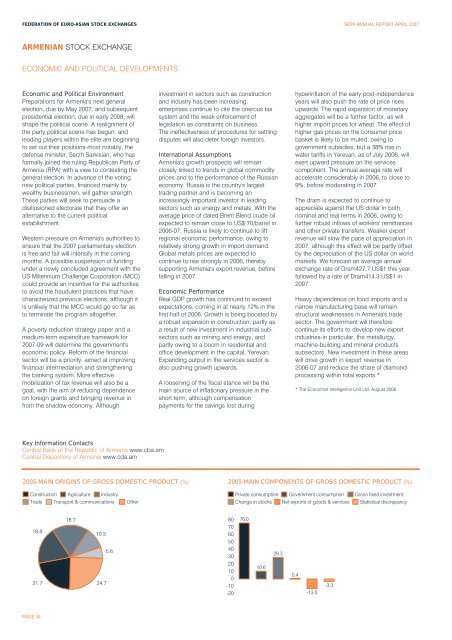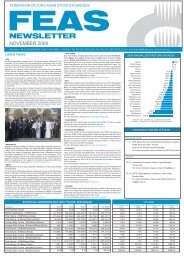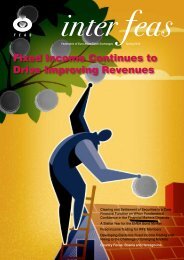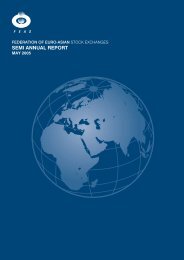Download - FEAS
Download - FEAS
Download - FEAS
You also want an ePaper? Increase the reach of your titles
YUMPU automatically turns print PDFs into web optimized ePapers that Google loves.
FEDERATION OF EURO-ASIAN STOCK EXCHANGES SEMI ANNUAL REPORT APRIL 2007<br />
ARMENIAN STOCK EXCHANGE<br />
ECONOMIC AND POLITICAL DEVELOPMENTS<br />
Economic and Political Environment<br />
Preparations for Armenia's next general<br />
election, due by May 2007, and subsequent<br />
presidential election, due in early 2008, will<br />
shape the political scene. A realignment of<br />
the party political scene has begun, and<br />
leading players within the elite are beginning<br />
to set out their positions-most notably, the<br />
defense minister, Serzh Sarkisian, who has<br />
formally joined the ruling Republican Party of<br />
Armenia (RPA) with a view to contesting the<br />
general election. In advance of the voting,<br />
new political parties, financed mainly by<br />
wealthy businessmen, will gather strength.<br />
These parties will seek to persuade a<br />
disillusioned electorate that they offer an<br />
alternative to the current political<br />
establishment.<br />
Western pressure on Armenia's authorities to<br />
ensure that the 2007 parliamentary election<br />
is free and fair will intensify in the coming<br />
months. A possible suspension of funding<br />
under a newly concluded agreement with the<br />
US Millennium Challenge Corporation (MCC)<br />
could provide an incentive for the authorities<br />
to avoid the fraudulent practices that have<br />
characterized previous elections, although it<br />
is unlikely that the MCC would go so far as<br />
to terminate the program altogether.<br />
A poverty reduction strategy paper and a<br />
medium-term expenditure framework for<br />
2007-09 will determine the government's<br />
economic policy. Reform of the financial<br />
sector will be a priority, aimed at improving<br />
financial intermediation and strengthening<br />
the banking system. More effective<br />
mobilization of tax revenue will also be a<br />
goal, with the aim of reducing dependence<br />
on foreign grants and bringing revenue in<br />
from the shadow economy. Although<br />
investment in sectors such as construction<br />
and industry has been increasing,<br />
enterprises continue to cite the onerous tax<br />
system and the weak enforcement of<br />
legislation as constraints on business.<br />
The ineffectiveness of procedures for settling<br />
disputes will also deter foreign investors.<br />
International Assumptions<br />
Armenia's growth prospects will remain<br />
closely linked to trends in global commodity<br />
prices and to the performance of the Russian<br />
economy. Russia is the country's largest<br />
trading partner and is becoming an<br />
increasingly important investor in leading<br />
sectors such as energy and metals. With the<br />
average price of dated Brent Blend crude oil<br />
expected to remain close to US$ 70/barrel in<br />
2006-07, Russia is likely to continue to lift<br />
regional economic performance, owing to<br />
relatively strong growth in import demand.<br />
Global metals prices are expected to<br />
continue to rise strongly in 2006, thereby<br />
supporting Armenia's export revenue, before<br />
falling in 2007.<br />
Economic Performance<br />
Real GDP growth has continued to exceed<br />
expectations, coming in at nearly 12% in the<br />
first half of 2006. Growth is being boosted by<br />
a robust expansion in construction, partly as<br />
a result of new investment in industrial subsectors<br />
such as mining and energy, and<br />
partly owing to a boom in residential and<br />
office development in the capital, Yerevan.<br />
Expanding output in the services sector is<br />
also pushing growth upwards.<br />
A loosening of the fiscal stance will be the<br />
main source of inflationary pressure in the<br />
short term, although compensation<br />
payments for the savings lost during<br />
hyperinflation of the early post-independence<br />
years will also push the rate of price rises<br />
upwards. The rapid expansion of monetary<br />
aggregates will be a further factor, as will<br />
higher import prices for wheat. The effect of<br />
higher gas prices on the consumer price<br />
basket is likely to be muted, owing to<br />
government subsidies, but a 38% rise in<br />
water tariffs in Yerevan, as of July 2006, will<br />
exert upward pressure on the services<br />
component. The annual average rate will<br />
accelerate considerably in 2006, to close to<br />
9%, before moderating in 2007.<br />
The dram is expected to continue to<br />
appreciate against the US dollar in both<br />
nominal and real terms in 2006, owing to<br />
further robust inflows of workers' remittances<br />
and other private transfers. Weaker export<br />
revenue will slow the pace of appreciation in<br />
2007, although this effect will be partly offset<br />
by the depreciation of the US dollar on world<br />
markets. We forecast an average annual<br />
exchange rate of Dram427.7:US$1 this year,<br />
followed by a rate of Dram414.3:US$1 in<br />
2007.<br />
Heavy dependence on food imports and a<br />
narrow manufacturing base will remain<br />
structural weaknesses in Armenia's trade<br />
sector. The government will therefore<br />
continue its efforts to develop new export<br />
industries-in particular, the metallurgy,<br />
machine-building and mineral products<br />
subsectors. New investment in these areas<br />
will drive growth in export revenue in<br />
2006-07 and reduce the share of diamondprocessing<br />
within total exports.*<br />
* The Economist Intelligence Unit Ltd, August 2006<br />
Key Information Contacts<br />
Central Bank of the Republic of Armenia www.cba.am<br />
Central Depository of Armenia www.cda.am<br />
2005-MAIN ORIGINS OF GROSS DOMESTIC PRODUCT (%)<br />
2005-MAIN COMPONENTS OF GROSS DOMESTIC PRODUCT (%)<br />
Construction Agriculture Industry<br />
Trade Transport & communications<br />
Other<br />
Private consumption Government consumption Gross fixed investment<br />
Change in stocks Net exports of goods & services Statistical discrepancy<br />
18.8<br />
21.7<br />
18.7<br />
10.5<br />
24.7<br />
5.6<br />
80<br />
70<br />
60<br />
50<br />
40<br />
30<br />
20<br />
10<br />
0<br />
-10<br />
-20<br />
76.0<br />
10.6<br />
29.3<br />
0.4<br />
-13.0<br />
-3.3<br />
PAGE 34
















